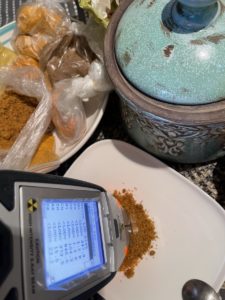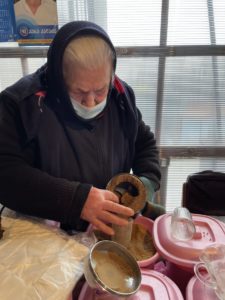In 2019, the Republic of Georgia faced a childhood lead poisoning crisis. A national survey had revealed that 41% of children ages 2-7 in the country had blood lead levels at or above 5 μg/dL (the level at which the CDC recommends intervention). This was a staggering discovery. Even small doses of lead in children can slow development and cause learning disabilities, among other dangerous health effects.
The government asked Pure Earth to join the investigation. Thanks to an effective collaboration, headed by the Georgian government involving research institutions, UNICEF, Pure Earth and others, in two years, the source of the problem was identified and stopped. A major source of lead exposure was lead chromate added to enhance the color of spices. Pure Earth helped to trace the lead adulteration to a few major spice suppliers. The government quickly put a stop to these operations, cleaning up the spice supply chain throughout the country.
This quick success was critical for Georgian children, but it very likely benefited children in New York as well.

After conducting a nine-year study on 50 different spices in New York City, the Department of Health found lead in over half of the samples. The Department also discovered that the Republic of Georgia was one of the countries most responsible for supplying lead-contaminated spices. Carolina Rodriguez from New York City Department of Health confirmed in 2017 that they had found cases of lead poisoning in New York related to spices imported from Georgia.
Because of the global food supply chain, contaminated spices and other foods routinely find their way into kitchens worldwide. In 2021, Consumer Reports released an alarming study that found high levels of toxic heavy metals in 126 brands of spices sold in U.S. supermarkets. That same year, two U.S. House subcommittee reports raised the alarm about widespread contamination of baby food.

Investigating Lead in Georgian Markets
Fortunately, the findings of widespread lead poisoning among children in Georgia galvanized the government into quick action. In 2019, the Georgian government approved the Clinical Protocol for the Early Detection and Elimination of the Toxic Exposure of Lead in Children, which aims to prevent the harmful impacts of lead, determine lead levels in the population, and effectively manage patients.
In parallel, Pure Earth initiated a study to identify the most prominent sources of lead pollution in Georgia, which included a detailed inventory of spices. The study was an important part of the Protecting Every Child’s Potential initiative, a global public-private partnership established by Pure Earth, UNICEF, and the Clarios Foundation.
“In the summer of 2020, we began monitoring spices in the regions of Samegrelo, Imereti, Guria, Adjara, Samtskhe-Javakheti, Kvemo Kartli and Shida Kartli, as well as in Tbilisi,” says Khatuna Akhalaia, Pure Earth’s Country Director in Georgia, “We studied local businesses on a door-to-door basis.”
The Pure Earth team in Georgia interviewed spice farmers, gathering data on soil conditions, the use of chemicals, as well as the drying, grinding, and packaging process. Since imported spices occupy a large portion of the market, Khatuna’s team also spoke with wholesale retailers who distribute imported materials.

A Toxic Mystery Solved
Based on an analysis of 77 spice businesses and 264 products, as well as discussions with local governments, the Pure Earth team was able to solve the toxic mystery. The smaller operators, like farmers and local markets, were not the main source of contamination. Rather, most of the lead was getting into spices during processing by large spice importers and wholesale retailers.
After investigating how these major warehouses and factories operate, the team identified the source: a dye called lead chromate added to spices to enhance color. Composed of two very toxic heavy metals, lead and hexavalent chromium, lead chromate is widely used as a yellow coloring pigment.
Using this information, the Georgian government swiftly passed regulation that targeted the problem. According to Pure Earth Georgia Director Khatuna Akhalaia, in two years since the intervention began, lead has now been almost completely eliminated from the spice market in Georgia.

A Ten-Year Plan to End Lead Poisoning
Unfortunately, spices are not the only source of lead contamination in Georgia. Pure Earth has launched a global “Rapid Marketplace Screenings” project to investigate products like spices, toys, cookware and other everyday items sold in markets worldwide. Pure Earth investigators are currently doing these investigations in 25 countries, including Georgia, continuing the work, which began with the lead investigations.
These initiatives will take place in collaboration with Georgia’s “State Strategy and Action Plan for Controlling the Toxic Impact of Lead (2020-2030),” an ambitious effort to minimize and ideally eliminate lead poisoning in Georgia.
If funding and determination continue, children in Georgia can look forward to a future free from the toxic effects of lead. And this is good news for children around the world too. By stopping contamination at its source, everyone benefits.
This post comes from Charlie Espinosa. It was adapted from an article written in Georgian by Otar Kiria, originally published in a Georgian news publication.
This work was possible thanks to the generous support of the Clarios Foundation. Support for the Rapid Marketplace Screenings comes from GiveWell, the Effective Altruism Global Health and Development Fund, and Open Philanthropy.

WATCH:






